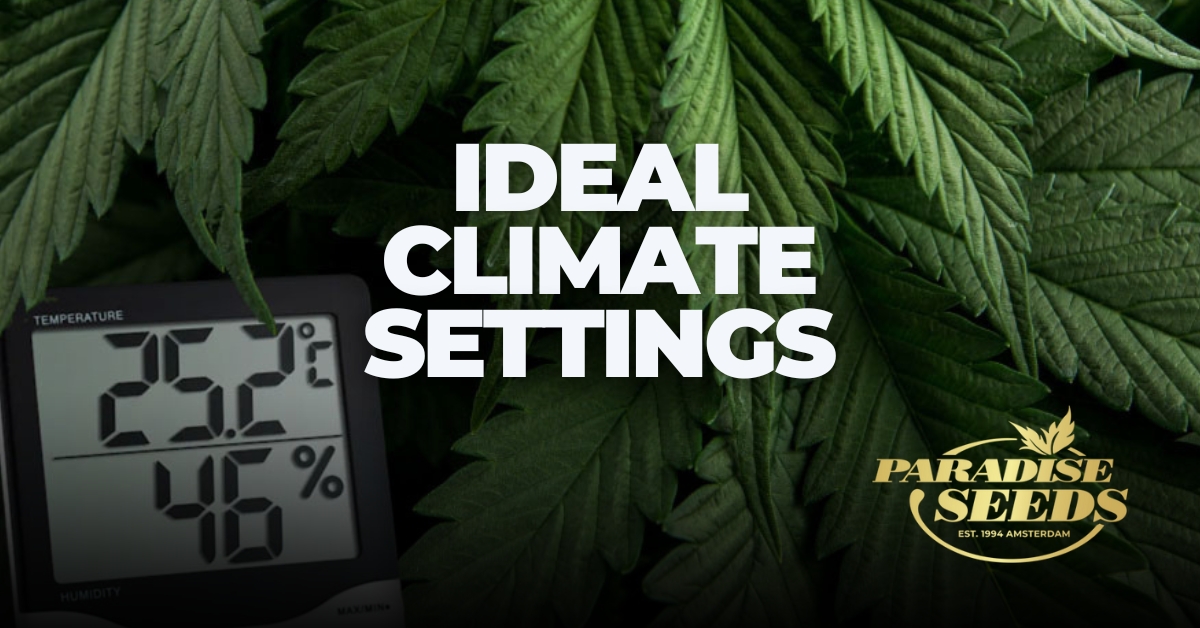Each stage of the plant’s life cycle has different climate needs that, when met, can lead to optimal growth. This article recommends the most ideal cannabis climate settings that you should try to keep steady and consistent within your cultivation space. Even though this consistency might only really be feasible to achieve indoors, it should give you guidance as to what conditions are optimal when growing outdoors as well.
Contents
Vapor Pressure Deficit (VPD) and Climate
One indicator to constantly monitor is VPD. It is a measure used in agriculture, horticulture, and environmental sciences to describe the difference between the amount of moisture in the air and the amount of moisture the air can hold when it is completely saturated (i.e., at 100% relative humidity).
VPD is expressed as Kpa (kilopascal), Bar, PSI (Pound-force per square inch) or kg/cm².
Low VPD and Plant Transpiration:
- Smaller Moisture Difference: A low VPD indicates that the air is relatively humid, meaning the difference between the moisture inside the leaf and the moisture in the surrounding air is small. This creates a weaker force for water vapor to move from the inside of the leaf to the outside air.
- Decreased Transpiration: With a lower difference, less water vapor is lost from the leaf through the stomata. Which means low transpiration rates.
- Stomatal Behavior: In conditions of low VPD, stomata tend to remain more open, as there is less risk of excessive water loss. This can allow for better carbon dioxide intake, supporting photosynthesis.
Impact of a Low VPD
- Risk of Disease: The increased humidity associated with low VPD can create conditions favorable for the development of fungal and bacterial diseases.
- Slower Nutrient Uptake: Since transpiration helps in the movement of nutrients from the soil to the plant, reduced transpiration can slow down nutrient uptake, potentially affecting plant growth.
- Lower Cooling: Transpiration also helps to cool the plant, a reduced transpiration can lead to higher leaf temperatures, especially in warm environments.
High VPD and Plant Transpiration
- Greater Moisture Difference: A high VPD means there is a significant difference between the moisture inside the leaf and the moisture in the surrounding air. This creates a strong force for water vapor to move from the inside of the leaf (where it is more humid) to the outside air (which is drier).
- Increased Transpiration: As a result of this difference, plants lose more water through their stomata, the tiny pores on the leaf surface. Which means high transpiration rates.
- Stomatal Response: To prevent excessive water loss under high VPD conditions, some plants may partially close their stomata, reducing transpiration but also limiting carbon dioxide intake, which can affect photosynthesis and growth.
Impact of High VPD
- Water Stress: If the plant cannot take up water fast enough from the soil to match the increased loss through transpiration, it may experience water stress.
- Reduced Growth: Prolonged high VPD can lead to reduced growth, wilting, and in severe cases, damage or death of the plant, especially if soil moisture is limited.
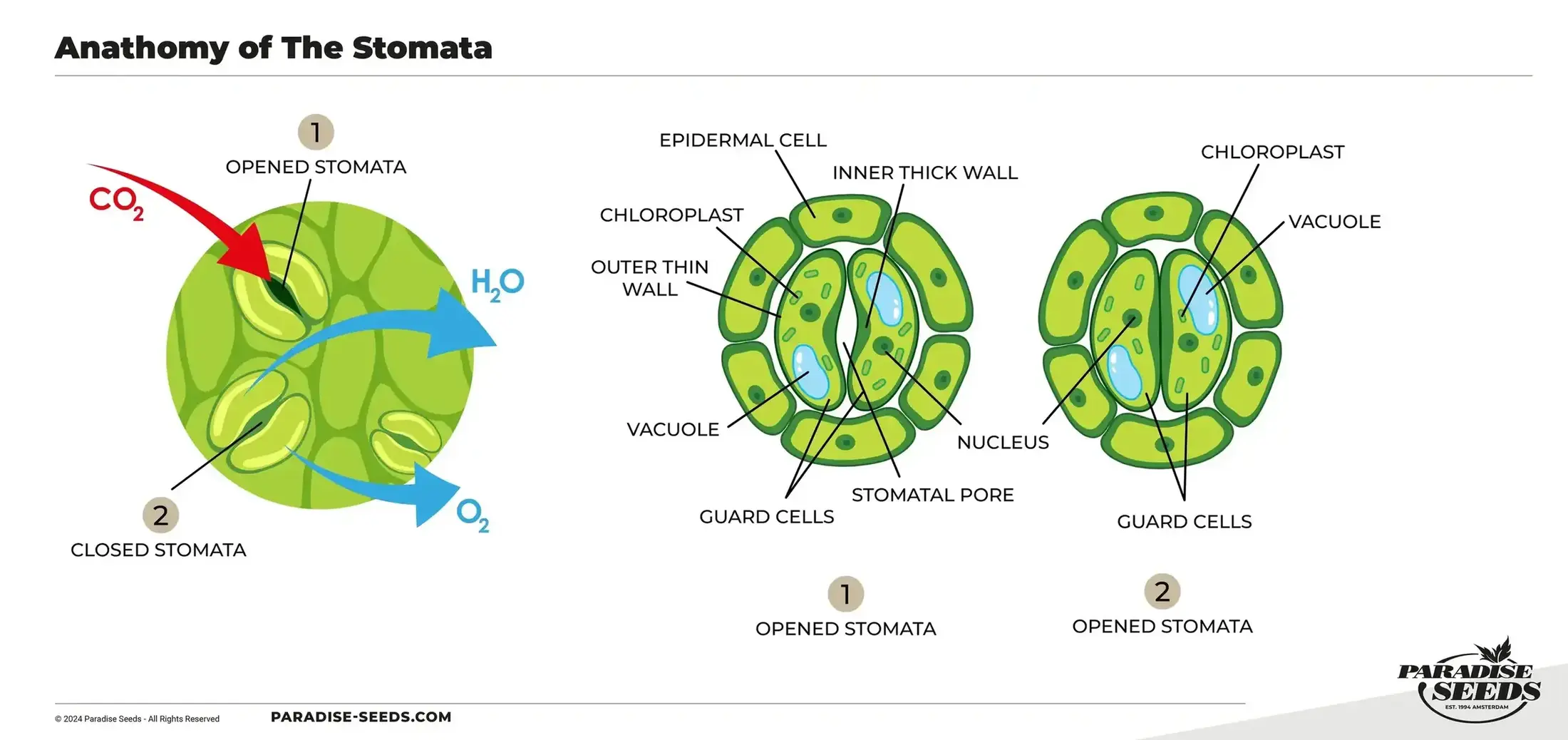
Suggested VPD per stage
For each of the phases a cannabis plant goes through, different VPD levels are optimal. See below the suggested VPD per phase.
Seedling Stage: Young plants and seedlings are more delicate and have less developed root systems. A low VPD between 0.4 to 0.8 Kpa ensures high humidity, which in turn helps to reduce water stress and encourages the development of roots and healthy foliage.
Vegetative Stage: During the vegetative stage, cannabis plants are focused on growing leaves, stems, and roots. A moderate VPD between 0.8 to 1.2 Kpa encourages healthy transpiration, which supports nutrient uptake and robust growth, while preventing excessive water loss.
Early Flowering Stage: During early flowering, a moderate VPD between 1 to 1.2 Kpa supports continued growth and the formation of flowers.
Late Flowering Stage: In late flowering, a slightly higher VPD between 1.2 to 1.6 Kpa helps to prevent mold and mildew, which can be problematic due to the dense buds that retain moisture. Lower humidity reduces the risk of bud rot while still maintaining adequate transpiration.
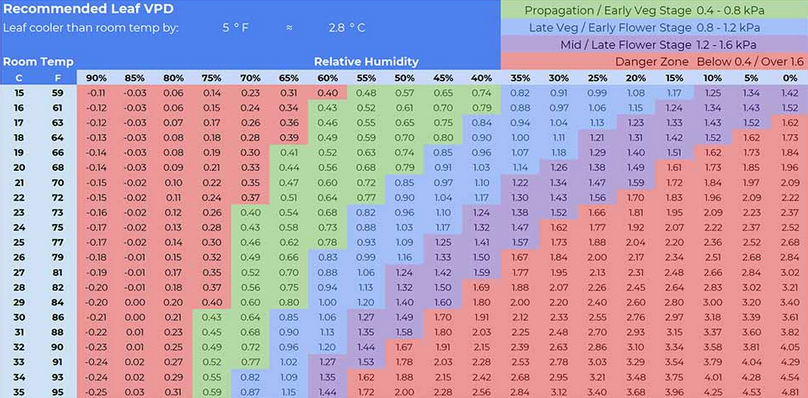
As can be seen in the chart above, the VPD in Kpa is a relation between both Temperature and Relative Humidity. Below we dive in depth about both of these important factors.
The Role of Temperature in Ideal Cannabis Climate Settings
A key component in cannabis climate settings is temperature control.The aim of temperature control during cultivation is to prevent extremes (either too hot or too cold).
Higher Temperatures: Can accelerate growth during the vegetative stage but may also increase the risk of heat stress, especially during flowering. It is crucial to ensure that temperatures do not exceed the optimal range, as excessive heat can cause leaf burn, stunted growth, and reduce the potency of flowers.
Lower Temperatures: Are useful during flowering to enhance quality and mimic natural autumn conditions. However, temperatures that are too low can slow growth, affect photosynthesis, and lead to issues like nutrient lockout.
Suggested Temperature per stage
Seedling Stage: Seedlings and clones are delicate and have not yet developed strong root systems. A slightly warmer day temperature between 24 and 27°C encourages faster root development and ensures that the young plants do not experience stress, which could stunt their growth. The warmth also supports cellular activity and metabolism, aiding in early growth.
Vegetative Stage: During the vegetative stage, cannabis plants are focused on building foliage, stems, and roots. A moderate to warm day temperature between 24 and 27°C supports robust photosynthesis, nutrient uptake, and overall vegetative growth. Temperatures on the higher end of this range can promote faster growth, provided that humidity and other factors are properly managed.
Flowering Stage: The flowering stage is critical for bud development. Slightly cooler day temperatures between 24 and 27°C help to encourage the production of dense, resinous buds. Cooler nights can bring out vibrant colors in some strains (like purples), enhance terpene production, and mimic natural conditions that the plant would experience outdoors.
Late Flowering: In the final weeks before harvest, cooler day temperatures between 22 and 25°C can help increase trichome production and preserve the quality of cannabinoids and terpenes. This stage is about fine-tuning the plant’s environment maximising resin production and preventing mold or bud rot, especially as the buds become denser.
Temperature Fluctuations: Your intention should be to minimise fluctuations in temperature during the day. A steady climate is the most comforting for your plant to reach its full potential.
Day and Night Temperature Difference: A small difference between daytime and nighttime temperatures (typically around 2 to 4°C) is beneficial for cannabis plants, as it simulates natural outdoor conditions. This difference helps to encourage proper metabolic function and can enhance the quality of the final harvest.
By maintaining these temperatures, growers can optimize the growth and development of cannabis plants, leading to healthy, vigorous plants and high-quality yields.
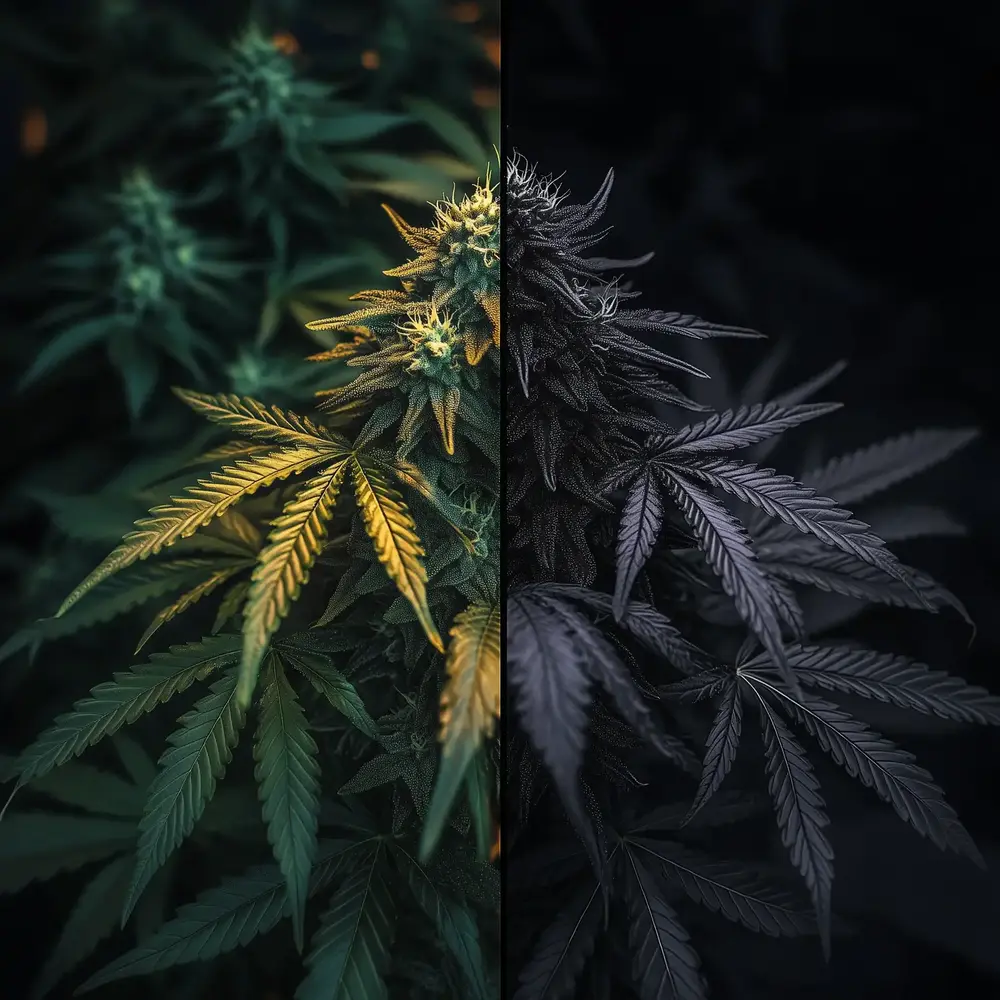
Relative Humidity
Humidity is another of the essential cannabis climate settings a grower neeeds to be constantly monitoring. Humidity is usually expressed as RH (Relative Humidity) and as a percentage. RH measures the water vapor held in the air.
The optimal relative humidity (RH) for cannabis plants varies depending on their stage of growth. Managing RH properly throughout the plant’s life cycle is crucial for maintaining plant health, optimizing growth, and maximizing yield and quality. The ideal RH levels for each stage change and these are our recommendations:
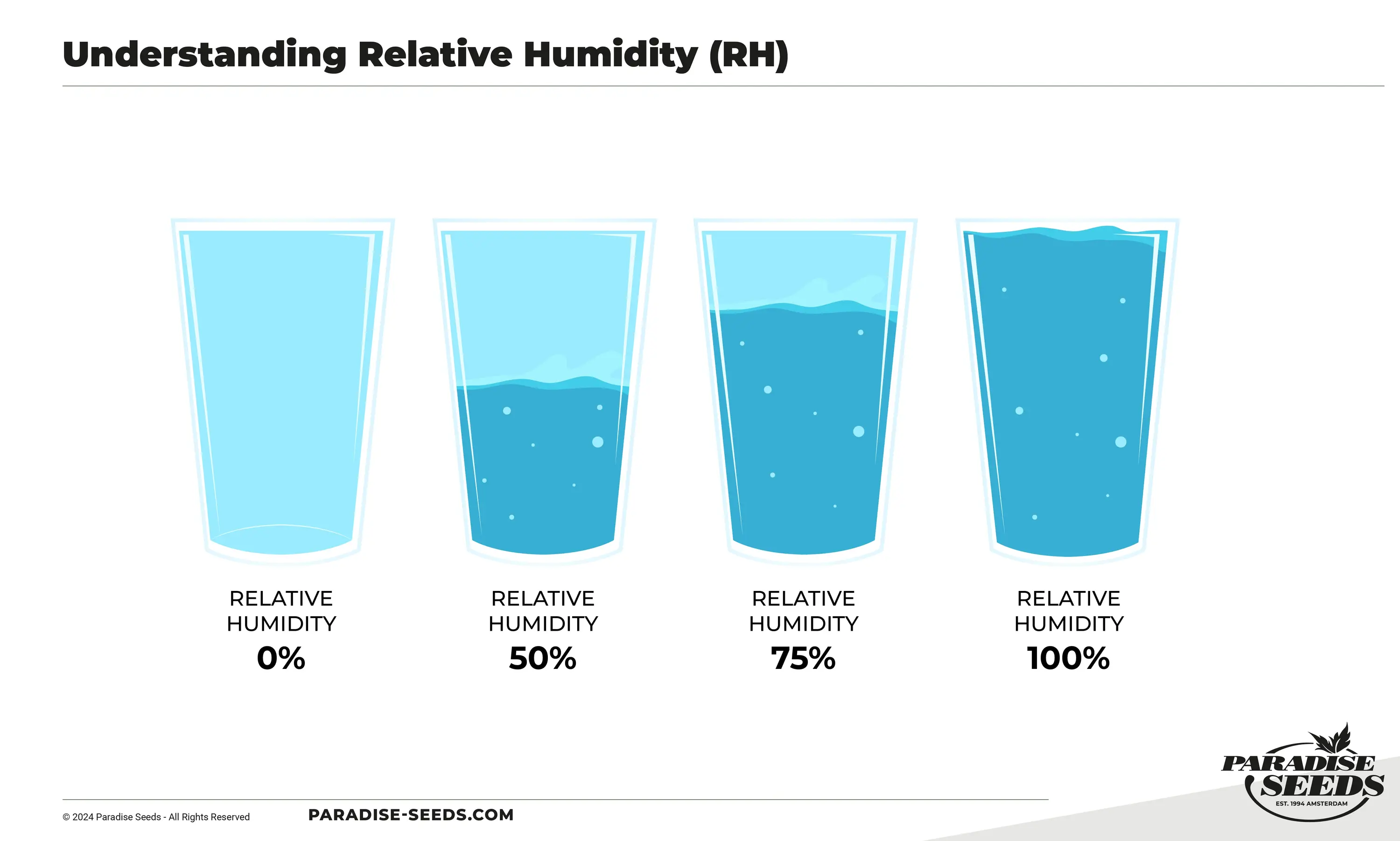
Suggested Relative Humidity per stage
Seedling Stage: Young seedlings and clones have underdeveloped root systems, so they rely heavily on moisture from the air to stay hydrated. Higher humidity levels between 80 and 90% ensure that the plants don’t lose too much moisture through transpiration, which helps prevent dehydration and encourages healthy root development. High RH also helps maintain the turgor pressure within the plant cells, supporting strong and rapid growth at this delicate stage.
Vegetative Stage: During the vegetative stage, cannabis plants are rapidly growing foliage and stems, and their root systems are becoming more established. A moderate to high RH between 60 and 80% helps support vigorous growth by ensuring that the plant has sufficient moisture for transpiration and nutrient uptake. However, slightly lower humidity than the seedling stage helps to encourage stronger root development, as the plant transitions to absorbing more water from the soil.
Flowering Stage: As the plant enters the flowering stage, lower humidity between 50 and 60% is essential to prevent mold and mildew, especially as the buds start to develop and become denser. Lower RH levels help reduce the risk of bud rot and other moisture-related diseases while still providing enough moisture for the plants to continue their metabolic processes.
Late Flowering: In the final stages of flowering, further reducing humidity between 40 and 50% helps protect the dense buds from mold and encourages the plants to produce more resin and trichomes as a natural defense mechanism. This not only enhances the potency of cannabinoids but also improves the terpene profile, leading to higher quality and more aromatic buds.
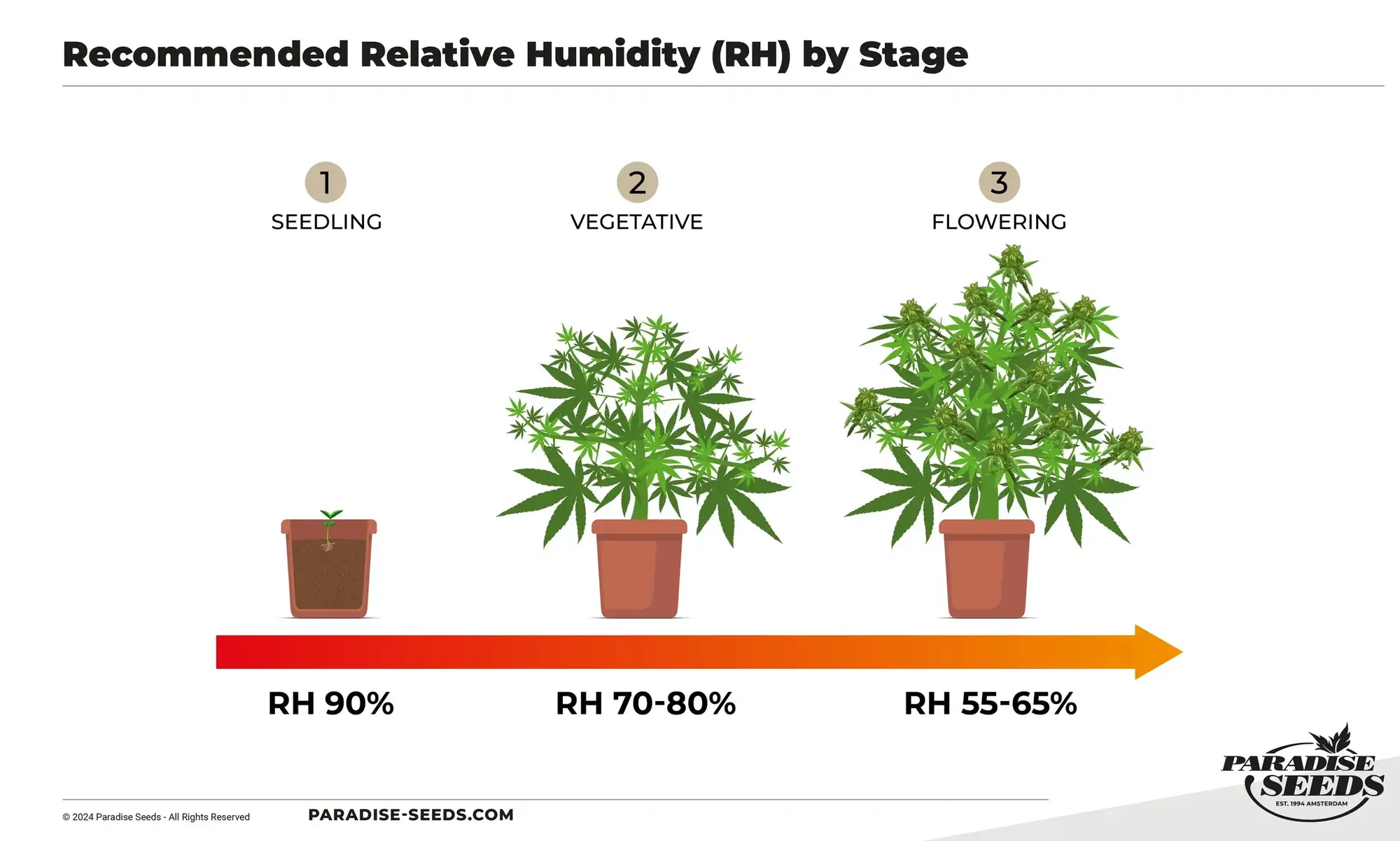
Air Circulation
Optimal air circulation is crucial for cannabis plants at every stage of their life cycle. Proper air movement helps regulate temperature, humidity, and CO₂ levels, reduces the risk of pests and diseases, and promotes strong stem growth.
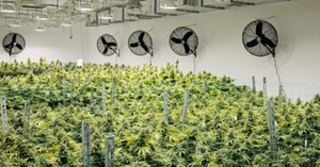
Suggested Air Circulation per stage
Seedling Stage: Seedlings and clones are delicate and can be easily damaged by strong air currents. Gentle, indirect airflow ensures that the environment remains fresh, with adequate CO₂ for photosynthesis, without stressing or physically damaging the young plants. Light airflow helps to strengthen the stems as they begin to grow, preparing them for more vigorous growth in later stages. It also prevents the buildup of stagnant air, which can lead to mold or damping-off disease.
Vegetative Stage: During the vegetative stage, cannabis plants grow rapidly, developing thick foliage. Moderate, consistent airflow ensures that all parts of the plant receive fresh air, helping to regulate temperature and humidity levels around the leaves. Consistent airflow also strengthens the stems and branches, making the plants more resilient and more able to support heavy buds later on. Proper air movement prevents hot spots and reduces the likelihood of pests like spider mites, which thrive in stagnant air conditions.
Flowering Stage: As the plants enter the flowering stage, dense buds begin to form, which can trap moisture and create a breeding ground for mold and mildew. Robust, focused airflow around the canopy and under the plants is essential to keep the canopy dry and ensure that moisture doesn’t accumulate around the buds. Airflow should be sufficient to move the leaves slightly. Additionally, circulating air under the canopy helps to prevent stagnant air pockets that could lead to mold and pests. The goal is to maintain a dry, healthy environment while still providing enough CO₂ for optimal bud development.
Late Flowering: In the final weeks before harvest, maintaining a dry environment is crucial to prevent mold and bud rot, especially as the buds become increasingly dense. Increased airflow with careful monitoring ensures that no moisture remains on or between the buds. Fans should be positioned to create gentle air movement through the canopy and under the plants, but care should be taken to avoid direct, strong airflow on the buds themselves, which could cause trichome damage.
By adjusting air circulation according to the stage of growth, growers can create an optimal environment for healthy cannabis plants, leading to higher yields and better-quality buds.
Co2 – Carbon Dioxide
Co2 (carbon dioxide) is a factor in optimizing crops through climate control and is a popular supplement used by growers operating in a controlled environment. Co2 generators are used for this purpose.
- Co2 contributes to plant growth and boosts yields
- A key component in the process called photosynthesis (the process of turning sunlight, Co2 and Water to produce Oxygen and energy).
- Cannabis typically thrives in a Co2 rich environment of between 800 – 1500 PPM.
- At some point Co2 Levels reach a saturation point, at which they don’t yield extra benefits for plant growth.
- Outdoor air contains Co2 and can range between 300 to 400 ppm (parts per million). In metropolitan areas this is usually higher.
Long exposure to higher levels of Co2 (>5.000 PPM) should be avoided and Co2 Sensors should indicate Co2 levels and prevent any potential health hazards. The USDA lists several Co2 concentrations that should be avoided.
Recommended Settings
| Seedlings | Vegetative | Flowering(Wk 1 – 3) | Flowering(Wk 4 – 8) | |
| Temperature (Day)* [°C] | 24 – 27 | 24 – 27 | 24 – 27 | 22 – 25 |
| Humidity [%] | 80 – 90 | 60 – 80 | 50 – 70 | 40 – 60 |
| Light Levels [μmol] | 100 – 200 | 200 – 400 | 600 – 1000 | 600 – 1000 |
| CO2** [PPM] | 800 – 1000 | 800 – 1000 | 800 – 1500 | 800 – 1500 |
| VPD [Kpa] | 0.4 – 0.8 | 0.8 – 1.2 | 1.0 – 1.2 | 1.2 – 1.6 |
*The Night temperature should be 2 to 4 degrees celsius lower than the day temperature to create a positive DIF.
**Long exposure to higher levels of CO2 (>5.000 PPM) should be avoided



